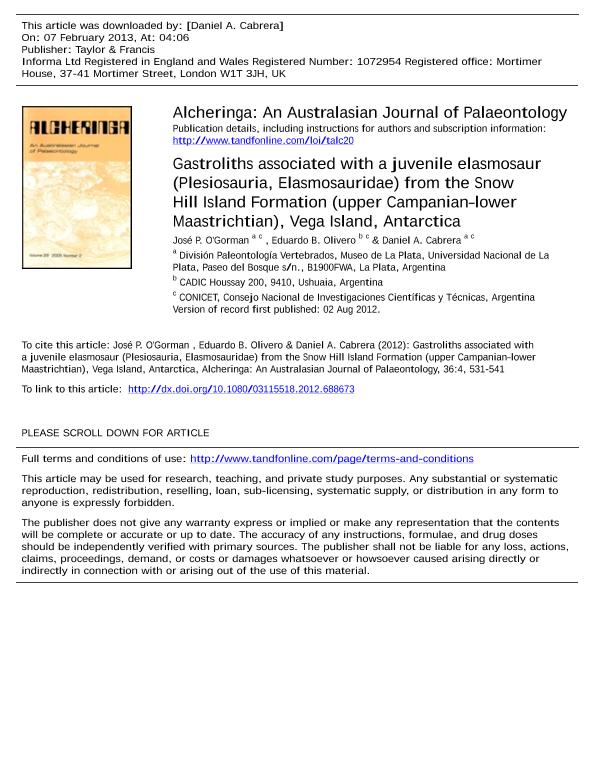Mostrar el registro sencillo del ítem
dc.contributor.author
O'gorman, Jose Patricio

dc.contributor.author
Olivero, Eduardo Bernardo

dc.contributor.author
Cabrera, Daniel Alfredo

dc.date.available
2020-01-15T20:48:49Z
dc.date.issued
2012-12
dc.identifier.citation
O'gorman, Jose Patricio; Olivero, Eduardo Bernardo; Cabrera, Daniel Alfredo; Gastroliths associated with a juvenile elasmosaur (Plesiosauria, Elasmosauridae) from the Snow Hill Island Formation (upper Campanian-lower Maastrichtian), Vega Island, Antarctica; Taylor & Francis Ltd; Alcheringa; 36; 4; 12-2012; 531-541
dc.identifier.issn
0311-5518
dc.identifier.uri
http://hdl.handle.net/11336/94843
dc.description.abstract
Gastroliths associated with a juvenile elasmosaur (Plesiosauria, Elasmosauridae) from the Snow Hill Island Formation (upper Campanian-lower Maastrichtian), Vega Island, Antarctica. Alcheringa 36, 531-541. ISSN 0311-5518.One of the unresolved problems concerning the palaeobiology of plesiosaurs is the function of gastroliths. A new juvenile specimen referred to Elasmosauridae indet., collected from the Cape Lamb Member of the Snow Hill Island Formation (upper Campanian-lower Maastrichtian) from Cape Lamb, Vega Island, Antarctic Peninsula with gastroliths, provides the opportunity to add information about this issue. The specimen consists of approximately 20% of a partially articulated skeleton including 333 gastroliths. Taphonomic evidence indicates rapid burial and possibly different taphonomic pathways for the dorsal (articulated) and caudal (disarticulated) regions. Analysis of the 333 gastroliths determined the mean major axis to be 14.32 mm, the mean maximum projection sphericity to be 0.7 and the standard deviation to be 1.1. Following Krumbein classification, most of the gastroliths are disk-shaped (35.4%), spheroid (34%) and cylindrical (21.3%). According to Powers's categories, most of the gastroliths are rounded (71.2%). Petrographically, the gastroliths that are larger than 15 mm (major axis) are mostly volcanic rhyolites (78.3%) and fine-grained quartz aggregates (11.6%); together with minor granitic rocks (3.1%), mudstones (3.1%) and aphanitic volcanics (3.9%); similar percentages were present among the smaller clasts. The acidic volcanic clasts likely derive from the volcanic Antarctic Peninsula Group (GPVA; Middle-Upper Jurassic). The mean values for sphericity and oblate-prolate index (OP index) indicate a fluvial origin for the gastroliths. The method of estimation of the maximum prey-size using gastroliths is discussed. The available data provides evidence against the hydrostatic function of the gastroliths because the total weight of the gastroliths is insufficient to modify the hydrostatic balance of the juvenile plesiosaur.
dc.format
application/pdf
dc.language.iso
eng
dc.publisher
Taylor & Francis Ltd

dc.rights
info:eu-repo/semantics/openAccess
dc.rights.uri
https://creativecommons.org/licenses/by-nc-sa/2.5/ar/
dc.subject
ANTARCTICA
dc.subject
ELASMOSAURIDAE
dc.subject
GASTROLITHS
dc.subject
PLESIOSAUR
dc.subject
SNOW HILL ISLAND FORMATION
dc.subject
TAPHONOMY
dc.subject
UPPER CRETACEOUS
dc.subject.classification
Otras Ciencias Biológicas

dc.subject.classification
Ciencias Biológicas

dc.subject.classification
CIENCIAS NATURALES Y EXACTAS

dc.title
Gastroliths associated with a juvenile elasmosaur (Plesiosauria, Elasmosauridae) from the Snow Hill Island Formation (upper Campanian-lower Maastrichtian), Vega Island, Antarctica
dc.type
info:eu-repo/semantics/article
dc.type
info:ar-repo/semantics/artículo
dc.type
info:eu-repo/semantics/publishedVersion
dc.date.updated
2020-01-15T19:21:09Z
dc.journal.volume
36
dc.journal.number
4
dc.journal.pagination
531-541
dc.journal.pais
Reino Unido

dc.journal.ciudad
Londres
dc.description.fil
Fil: O'gorman, Jose Patricio. Consejo Nacional de Investigaciones Científicas y Técnicas; Argentina. Universidad Nacional de La Plata. Facultad de Ciencias Naturales y Museo. División Paleontología Vertebrados; Argentina
dc.description.fil
Fil: Olivero, Eduardo Bernardo. Consejo Nacional de Investigaciones Científicas y Técnicas. Centro Austral de Investigaciones Científicas; Argentina
dc.description.fil
Fil: Cabrera, Daniel Alfredo. Universidad Nacional de La Plata. Facultad de Ciencias Naturales y Museo. División Paleontología Vertebrados; Argentina. Consejo Nacional de Investigaciones Científicas y Técnicas; Argentina
dc.journal.title
Alcheringa

dc.relation.alternativeid
info:eu-repo/semantics/altIdentifier/doi/http://dx.doi.org/10.1080/03115518.2012.688673
dc.relation.alternativeid
info:eu-repo/semantics/altIdentifier/url/https://www.tandfonline.com/doi/abs/10.1080/03115518.2012.688673
Archivos asociados
